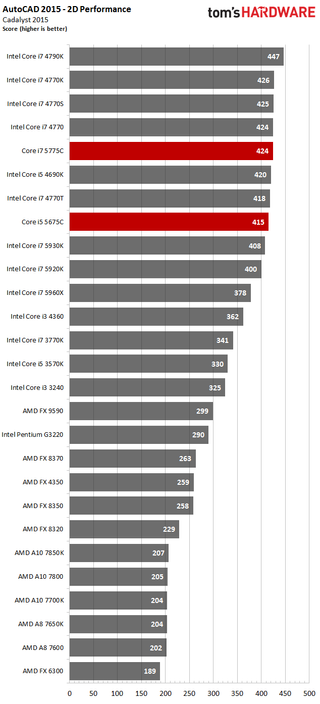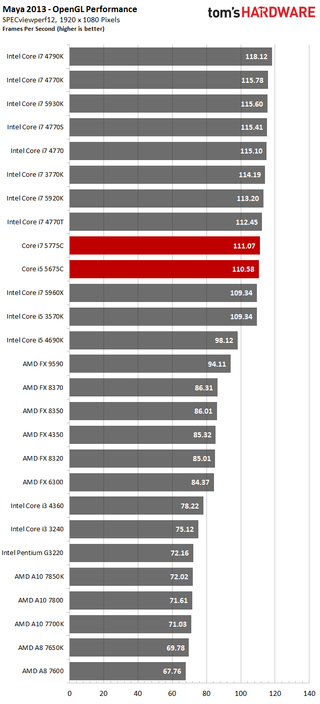Broadwell: Intel Core i7-5775C And i5-5675C Review
Workstation Applications
The following benchmarks are based on AutoCAD 2015, Cadalyst 2015, and three modules of SPECviewperf 2015. They were specifically chosen to represent the CPU performance in this context well, in spite of us using a Palit GeForce GTX 980 Super JetStream OC graphics card and not a workstation graphics card.
AutoCAD 2015 2D and 3D Performance
We’ve already described why and how we’re using AutoCAD in the integrated graphics section. Suffice it to say here that the CPU needs to help out quite a bit when it comes to 2D graphics acceleration, since this type of acceleration hasn’t existed via the GPU since Microsoft Windows Vista. Neither the driver model nor the unified shader architecture provides this functionality.
The positions in this benchmark are solely determined by the CPU, since the speed of the graphics is the same all around.

It’s interesting that the smaller CPU comes out a little bit ahead for 3D yet again. This trend reverses once SMT has been turned off, though.

Maya 2013
With Autodesk’s Maya 2013, a current and popular application was added to the benchmark suite. Viewport 2.0 isn’t part of the results on purpose, since it’s based on DirectX. This means that this benchmark is based exclusively on OpenGL. The render modes used for this benchmark are shaded, ambient occlusion, multi-sample anti-aliasing, and transparency, and the model consists of 727,500 vertices.

Showcase 2013
Showcase 2013 is a DirectX-based benchmark. Autodesk might still be the only major company to have made the jump to DirectX, but many smaller developers have taken the plunge as well. The benchmark model used for this benchmark uses eight million vertices, as well as render modes such as shading, projected shadows, and self-shadowing. What it comes down to in the end is the clock frequency.

SolidWorks 2013 SP1
The different models for our SolidWorks 2013 workloads range in size from 2.1 to 21 million vertices. Individual tests use the software's many rendering modes, including a shaded mode, shaded with edges, ambient occlusion, shaders and environment maps. Compared to SPECapc for SolidWorks 2013, the CPU test is gone, the number of models is lower and a benchmark with parallax effects was added.
Stay on the Cutting Edge
Join the experts who read Tom's Hardware for the inside track on enthusiast PC tech news — and have for over 25 years. We'll send breaking news and in-depth reviews of CPUs, GPUs, AI, maker hardware and more straight to your inbox.

Current page: Workstation Applications
Prev Page Rendering, Encoding, Compression, Arithmetic Next Page Conclusion-
RNOblivion Proof read your articles. This seems to be an increasing prevalent theme of Tom's over the last couple years.Reply -
greghome are these numbers real?.............Not only does it match lower mid range cards, but it completely destorys AMD's APUs........Reply
:shock: -
Nuckles_56 With the Sandra 2015 benchmark on the first page, you are testing the i7 7557c against the i7 4790k instead of the i7 5775cReply -
babernet_1 Sad how AMD is absolutely shoved into the dust bin. I hope their upcoming Zen next year will be worthwhile with its 14nm process and more Intel-like cores.Reply
-
wtfxxxgp This is exactly what I said to a buddy of mine about a month ago. Everyone is going on about how little Intel has done with CPUs over the past few years - presumably due to no real competition from AMD. Then people starting looking to Zen as being the real competitor for Intel and saying things like "Intel are in for a shock" - I had the view that Intel weren't resting on their laurels all this time - they've just been biding their time and doing amazing things in a hush hush manner. When Zen is released it will soon be completely obliterated by some of the tech that Intel would have been working on in the meantime - AMD has lagged too far behind for too long and love them or hate them, Intel is the benchmark when it comes to CPUs - period. They own this space, and these 2 chips have just rendered AMD APUs completely useless now. I'd be interested in this for a HTPC solution with some light gaming - League of Legends etc. This is impressive, however, like the article concluded, what a poor time for them to be released.Reply -
Grognak Wow. 93% better average framerate in GTA V than a 7850K with DDR3-2400 RAM... And that's just the i5. Incredible.Reply -
shrapnel_indie Since Broadwell is unlocked, would have been interesting to see how they overclocked. Yeah Skylake is breathing down the neck of Broadwell now thanks to the delays it suffered... but still would be fun to see.Reply
You’ve waited this long—why not hang tight for a few months for Skylake and start anew with 100-series chipsets, DDR4 and the return of unlocked 95W K-series CPUs?
Last I heard Skylake was supposed to support DDR3 and DDR4. Was that just a rumor that wasn't the truth or will it actually support DDR3 as well?
-
alpha27 heh iris coming close to a 750gtx 500 cuda core NVidia better watch out heyReply
hmm if intel whacked a few iris's on a gfx chip and did there thing they could possibly beat NVidia...and make even more money lol, hmm mutli 128mb ring buses and iris core's and hbm...delicious -
de5_Roy it's a good review. two big reviews back to back, nice job. :)Reply
i missed some things:
unlocked broadwells but no o.c. not even a little look into how these overclock and behave o.c.ed.
no comparison (gaming, power use, htpc etc.) with the desktop haswell i5 and i7 -R cpus' iris pro igpus. the amd comparisons were good though. i hope you guys test these against the haswell iris pro later.
in some of the charts, the core i7 5775 was written as i7 7557.
in the test setup page, system memory section, is it "transcend" instead of "transcent"?
edit:
one last thing: do these unlocked broadwell cpus really have 16x gen 3.0 lanes off the processor? i thought these were soc dies (with southbridge disabled) with 8x gen 3.0 lanes. -
SteelCity1981 not surprising given that it has an irs pro gpu in it, that's intel top of the line gpu. now obv even with that said it's in no competition with highend gpus from NVidia or amd as any apu's gpu would get destroyed, but what's good is the fact that it's helping to push gpus on apu's to become better and better and since intel has greatly stepped up their game in the apu's gpu department i'd expect amd to step up their game even further and push back. I also see that since there is such a big gain with broadwells gpu, that skylake won't see any real jump in that department. i'd imagine that the irs 6000 series is going to carry over onto skylake with little improvement over broadwells irs 6200.Reply
Most Popular

